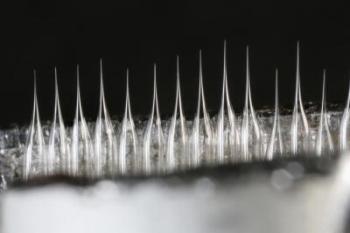Mar 26 2013
EPFL researchers are using the electrical properties of a scanning electron microscope to change the size of glass capillary tubes -- Their method has already been patented as it could pave the way to many novel applications
 A few of these commercial pre-shrunk nano-capillaries have had their end diameter reduced to a few nanometers, from an original 200 nm, thanks to an electron microscope at EPFL's Center for MicroNanotechnology. Credit: Alain Herzog / EPFL
A few of these commercial pre-shrunk nano-capillaries have had their end diameter reduced to a few nanometers, from an original 200 nm, thanks to an electron microscope at EPFL's Center for MicroNanotechnology. Credit: Alain Herzog / EPFL
Have you ever thrown into the fire - even if you shouldn't have - an empty packet of crisps? The outcome is striking: the plastic shrivels and bends into itself, until it turns into a small crumpled and blackened ball. This phenomenon is explained by the tendency of materials to pick up their original features in the presence of the right stimulus. Hence, this usually happens when heating materials that were originally shaped at high temperatures and cooled afterwards.
EPFL researchers realized that this phenomenon occurred to ultrathin quartz tubes (capillary tubes) under the beam of a scanning electron microscope. "This is not the original microscope's purpose. The temperature increase is explained by an accumulation of electrons in the glass. Electrons accumulate because glass is a non-conductive material." explains Lorentz Steinbock, researcher at the Laboratory of Nanoscale Biology and co-author of a paper on this subject published in Nano-letters.
As the glass shrinks, it can be seen live on the microscope screen. "It's like a glass-blower. Thanks to the possibilities provided by the new microscope at EPFL's Center of Micronanotechnology (MIC), the operator can adjust the microscope's voltage and electric field strength while observing the tube's reaction. Thus, the person operating the microscope can very precisely control the shape he wants to give to the glass", says Aleksandra Radenovic, tenure-track assistant professor in charge of the laboratory.
At the end of this process, the capillary tube's ends are perfectly controllable in diameter, ranging from 200 nanometers to fully closed. The scientists tested their slimmed down tubes in an experiment aiming to detect DNA segments in a sample. The test sample was moved from one container to another on a microfluidic chip. Whenever a molecule crossed the "channel" connecting the containers, the variation of the ion current was measured. As expected, the EPFL team obtained more accurate results with a tube reduced to the size of 11 nm than with standard market models. "By using a capillary tube costing only a few cents, in five minutes we are able to make a device that can replace "nano-channels" sold for hundreds of dollars!" explains Aleksandra Radenovic.
These nano-fillers have a potential beyond laboratory usage. "We can imagine industrial applications in ultra-high precision printers, as well as opportunities in surgery, where micro-pipettes of this type could be used at a cell's scale", says the researcher.
For the time being, the method for manufacturing nano-capillary tubes is manual, the transition to an industrial scale will take some time. However, the researchers have been able to demonstrate the concept behind their discovery and have registered a patent. Therefore, the road is already paved.